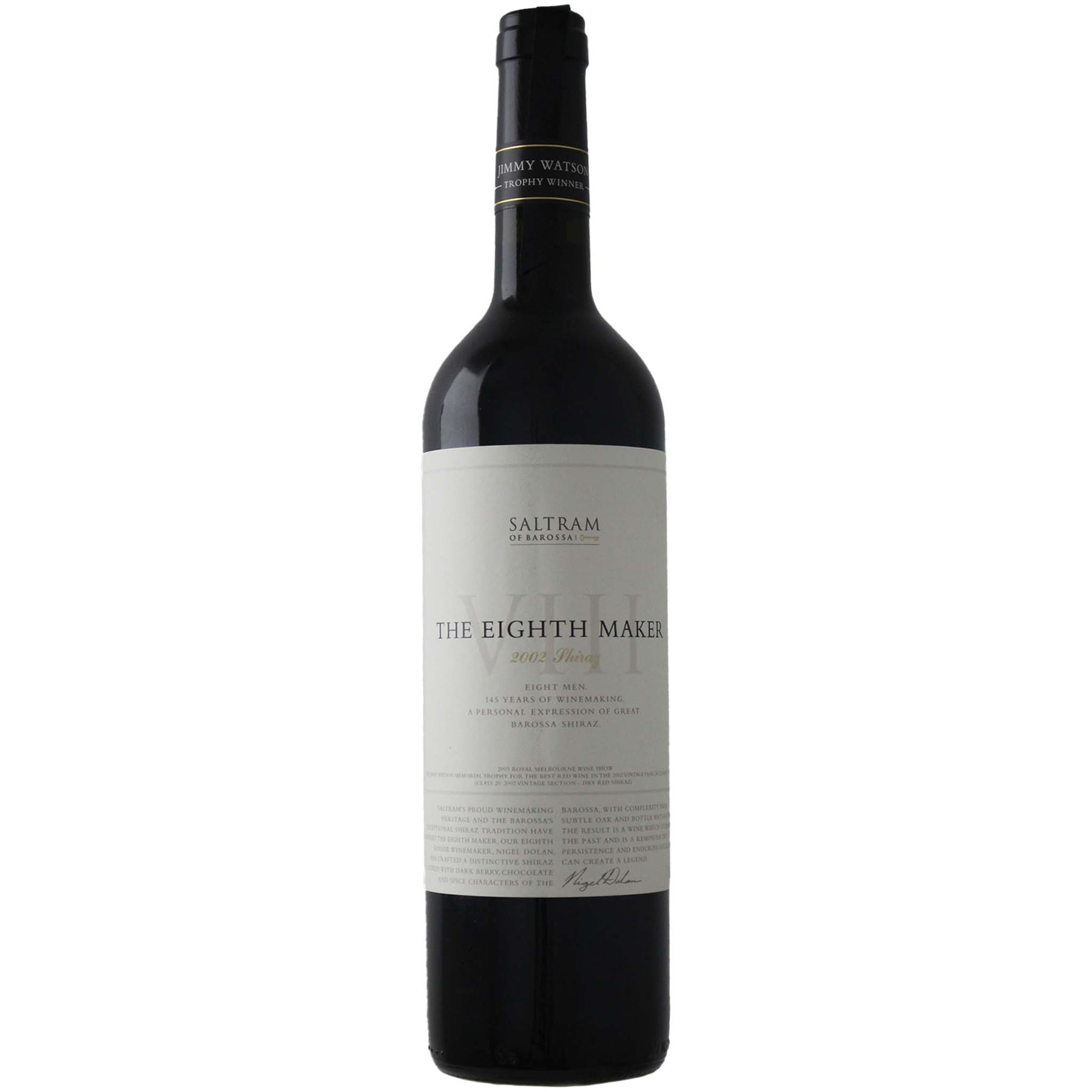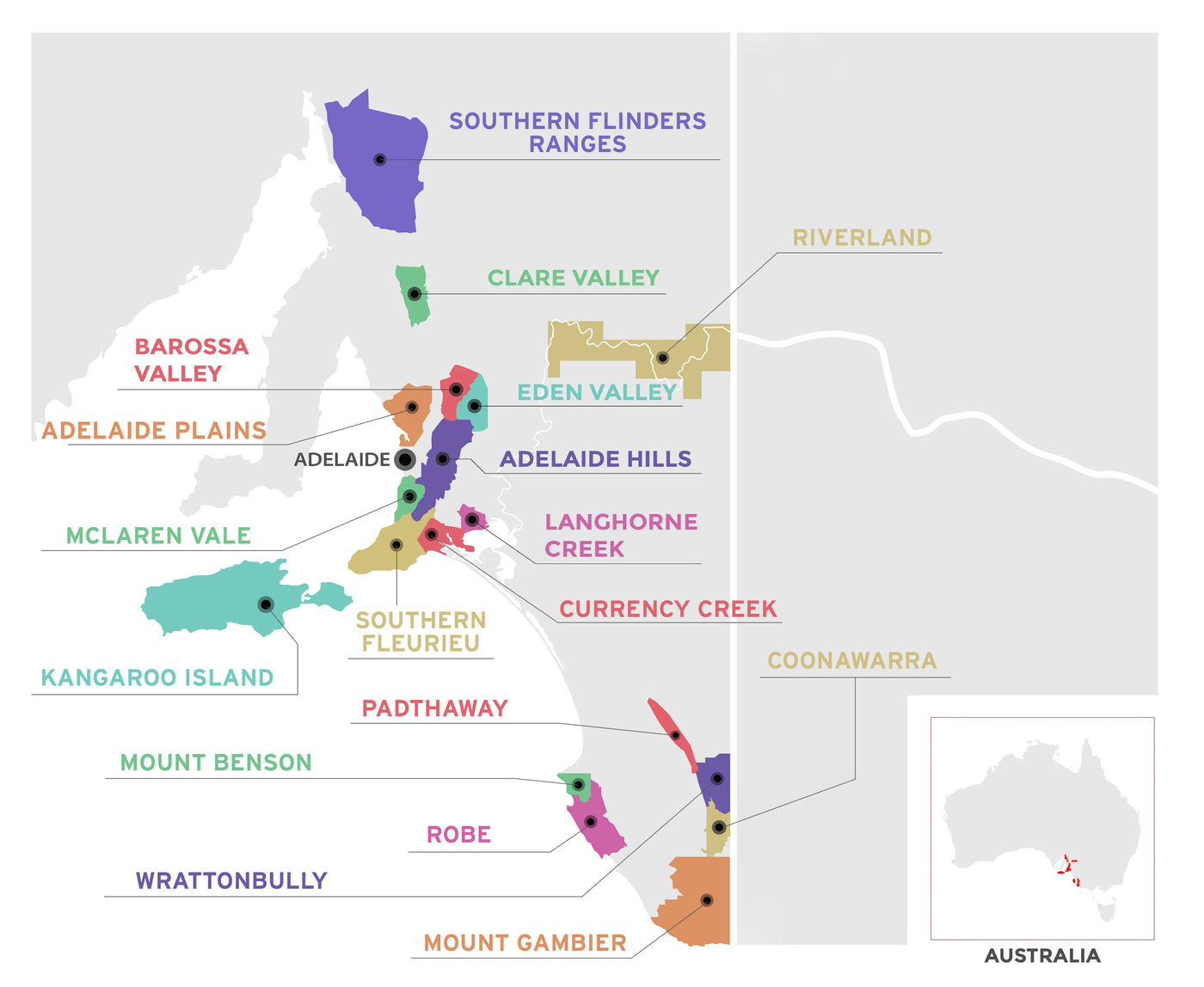

Saltram The Eighth Maker Shiraz 2002
Style: Red Wine
Variety: Shiraz
Closure: Cork
Saltram The Eighth Maker Shiraz 2002
Warehouse
34 Redland Drive
Vermont VIC 3133
Australia
Critic Score: 95
Alcohol: 14.0%
Size: 750 ml
Drink by: Now
Jimmy Watson Memorial Trophy for the best one-year-old red wine - Royal Melbourne Wine Show 2003
Saltram's father and son founders, William and Edward Salter, made their first wine in 1862. Over the following 16 decades, there have only been ten senior winemakers in charge at Saltram, testament to exceptional standards and commitment. The eighth winemaker, Nigel Dolan, was appointed in 1992 and held the position for 15 years. Dolan is widely credited with resurrecting Saltram's fortunes after a tumultuous period under owners, Seagram, the giant Canadian spirit company. The Eighth Maker Shiraz was launched in the 2000 vintage to reflect the character of the Barossa: outstanding Shiraz fruit, a sense of history and a hand-made approach to winemaking. Fruit is selected from some of the very best low-yielding vineyards in the Barossa to craft this exceptional wine.
"Pretty impressive stuff! Big, very dense wine with lovely chocolate, essence of blackberries and attractive spicy oak. Long. Powerful wine with a big future." Bob Campbell MW
"Saltram The Eighth Maker 2002 was crafted to capture the exceptional fruit characters and the outstanding quality of the fruit from the 2002 vintage. Early in the season the winemaker singled out certain vineyard parcels as potential blend components. These vineyards were carefully tended to ensure that the fruit reached its full potential, with each parcel being carefully monitored so it could be harvested at perfect ripeness. The bunches were partially de-stemmed and crushed into 8 tonne open fermenters to undergo fermentation under traditional heading down boards. The use of heading-down boards and the retention of some stems in the must added to the complexity and intensity of the finished wine. After a 10-day ferment on skins, the wine was pressed and transferred into new and seasoned French and American oak for 22 months maturation prior to blending and bottling.
The wine is deep velvet red with rich violet hues in the glass. The aromas present on the nose are, the very essence of Barossa Shiraz. Complex, layered aromas of blackcurrant, liquorice, spice dark berry and cherry continue to develop further complexity on the elegant, complex palate. Subtle French oak notes and refined bottle maturation characters complete this magnificent wine." Saltram
Expert reviews
"A super-stylish and contemporary shiraz with all the bells and whistles. Its brambly, smoky aromas of pristine dark cherries, cassis and cedary oak are backed by undertones of smoked bacon and licorice. Silky-smooth and spotless, its sumptuous and harmoniously crafted palate is saturated with flavours of dark berries, plums and dark chocolate, backed by suggestions of smoked meats. Framed by the finest of tannins, it's exceptionally long and measured, culminating in a slightly salty and savoury finish. Drink 2014-2022+." Jeremy Oliver – 97 points
"Pretty impressive stuff! 14% alc, 50% new and seasoned hogsheads, 70% French. Big, very dense wine with lovely chocolate, essence of blackberries and attractive spicy oak. Long. Powerful wine with a big future." Bob Campbell MW, The Real Review - 96 points
Awards
Jimmy Watson Memorial Trophy for the best one-year-old red wine - Royal Melbourne Wine Show 2003
About the winery

William Salter arrived in South Australia from England in 1839 and five years later purchased land near Angaston in the newly opened land survey known as the Barossa Valley. A deeply religious man, he named the property "Mamre Brook" after an Old Testament camping spot west of the Dead Sea. In 1859, he founded Saltram with his son Edward under the name of W. Salter & Son. They planted the first vines in the Barossa - 10 acres of Shiraz at the eastern end of the property. A shed was erected for making wine and a cellar was carved out of a nearby hill. Their first vintage in 1862 produced 1800 gallons (8000 litres) of a wine they called 'No. 1 Shiraz'.
William Salter passed away in 1871, leaving Edward to run the property. In 1873, by which time the vineyard had grown to 25 acres, Edward employed Alfred Percy Birks (who subsequently set up AP Birks' Wendouree winery in the Clare Valley) to introduce Saltram wines to New Zealand. In 1882, Thomas Hardy & Sons agreed to purchase and market all of Saltram's production, which led to the establishment of Saltram in the English trade. By 1891, the size of the vintage had grown to 182,000 litres, 3/4 of which was high quality dry red, mainly shiraz, for export markets.
Edward's sons, Charles and Leslie, joined the business in 1898. Charles was appointed manager until he left in 1902 to start his own business and Leslie succeeded his brother. Leslie became close friends with Ronald Martin of Stoneyfell and, in 1920, Saltram was converted to a company and Stoneyfell took a one-third interest. Following Leslie Salter's retirement in 1937, Saltram was managed by Stoneyfell and in 1941 it became a wholly owned subsidiary of Stoneyfell. The two companies worked in tandem, winemaking was carried out at Saltram and maturation and bottling at Stoneyfell.
The legendary Peter Lehmann was appointed Winemaker/Manager in 1959, a position he held for 20 years. Lehmann introduced the Mamre Brook label in 1963, which became one of the most sought-after red wines in South Australia. The Dalgety Pastoral Company took ownership of Saltram in 1972, but disposed of the winery shortly before the 1979 vintage, leaving wine maker Peter Lehmann without a job and many grape contractors without a buyer for the year’s crop. Lehmann parted company with Saltram to start Peter Lehmann Wines and rescued the growers in time for the vintage.
From 1979 through to the early 1990s were difficult times at Saltram under the new owners, Seagram, the giant Canadian spirit company. They had little understanding of wine and scant respect for history, continually shifting the focus on wine styles. Wine quality deteriorated and the flagship brands Mamre Brook and Metala gave way to Saltram Pinnacle Selection, widely viewed in the industry at the time as a poor joke.
Yet Saltram survived the Seagram period. Just two years before the end of that sorry time, in 1992, stability returned when Nigel Dolan was appointed Chief Winemaker, a position he held for 15 years. Under new owners Rothbury in 1994 and then Mildara Blass in 1996, Nigel took Saltram back to its roots, focusing on Barossa sourced grapes and styles which had made Saltram famous. For example, Dolan introduced Saltram No 1 Shiraz as a super-premium, rich red wine in the classic Barossa mould. The wine took its name from the very first wine made by Edward Salter in 1862. Nigel's achievements include being named South Australian Red Winemaker of the Year in 1996 and Barossa Winemaker of the Year in 2000.
In 2009, Saltram celebrated its 150th anniversary and to mark this milestone released the first vintage of The Journal Centenarian Old Vine Shiraz as homage to the expansive 'Vignerons Journals' kept by the Salters - from the first vine plantings in 1859, the journals meticulously recorded vineyard and winemaking activities.
Under Mildara Blass, which later became Foster's Group, Foster's Wine Estates and finally Treasury Wine Estates in 2005, Saltram has enjoyed an extended period of stability and growth. For over 16 decades, only ten senior winemakers have been in charge at Saltram - testament to the exceptional standards and commitment that the portfolio is built upon. The current winemaker is Alex MacKenzie, who took over from Shavaughn Wells in 2017, when she left to work at TWE stablemate Penfolds.


South Australia
South Australian is responsible for more than half the production of all Australian wine. It is home to more than 900 wineries across 18 wine regions. The regions are Adelaide Hills, Adelaide Plains, Barossa Valley, Clare Valley, Coonawarra, Currency Creek, Eden Valley, Kangaroo Island, Langhorne Creek, McLaren Vale, Mount Benson, Mount Gambier, Padthaway, Riverland, Robe, Southern Fleurieu, Southern Flinders Ranges and Wrattonbully.
Many of the well-known names in the South Australian wine industry established their first vineyards in the late 1830s and early 1840s. The first vines in McLaren Vale were planted at Reynella in 1839 and Penfold's established Magill Estate on the outskirts of Adelaide in 1844.
South Australia has a vast diversity in geography and climate which allows the State to be able to produce a range of grape varieties - from cool climate Riesling in the Clare and Eden Vallies to the big, full bodied Shiraz wines of the Barossa Valley and McLaren Vale. Two of Australia's best-known wines, Penfolds Grange and Henschke Hill of Grace, are produced here. There is much to discover in South Australia for the wine lover.
